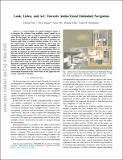| dc.contributor.author | Gan, Chuang | |
| dc.contributor.author | Zhang, Yiwei | |
| dc.contributor.author | Wu, Jiajun | |
| dc.contributor.author | Gong, Boqing | |
| dc.contributor.author | Tenenbaum, Joshua B | |
| dc.date.accessioned | 2022-02-03T20:01:42Z | |
| dc.date.available | 2021-12-07T19:51:18Z | |
| dc.date.available | 2022-02-03T20:01:42Z | |
| dc.date.issued | 2020-09 | |
| dc.date.submitted | 2020-05 | |
| dc.identifier.isbn | 978-1-7281-7395-5 | |
| dc.identifier.issn | 2577-087X | |
| dc.identifier.uri | https://hdl.handle.net/1721.1/138365.2 | |
| dc.description.abstract | © 2020 IEEE. A crucial ability of mobile intelligent agents is to integrate the evidence from multiple sensory inputs in an environment and to make a sequence of actions to reach their goals. In this paper, we attempt to approach the problem of Audio-Visual Embodied Navigation, the task of planning the shortest path from a random starting location in a scene to the sound source in an indoor environment, given only raw egocentric visual and audio sensory data. To accomplish this task, the agent is required to learn from various modalities, i.e., relating the audio signal to the visual environment. Here we describe an approach to audio-visual embodied navigation that takes advantage of both visual and audio pieces of evidence. Our solution is based on three key ideas: a visual perception mapper module that constructs its spatial memory of the environment, a sound perception module that infers the relative location of the sound source from the agent, and a dynamic path planner that plans a sequence of actions based on the audio-visual observations and the spatial memory of the environment to navigate toward the goal. Experimental results on a newly collected Visual-Audio-Room dataset using the simulated multi-modal environment demonstrate the effectiveness of our approach over several competitive baselines. | en_US |
| dc.language.iso | en | |
| dc.publisher | Institute of Electrical and Electronics Engineers (IEEE) | en_US |
| dc.relation.isversionof | http://dx.doi.org/10.1109/ICRA40945.2020.9197008 | en_US |
| dc.rights | Creative Commons Attribution-Noncommercial-Share Alike | en_US |
| dc.rights.uri | http://creativecommons.org/licenses/by-nc-sa/4.0/ | en_US |
| dc.source | arXiv | en_US |
| dc.title | Look, Listen, and Act: Towards Audio-Visual Embodied Navigation | en_US |
| dc.type | Article | en_US |
| dc.identifier.citation | Gan, Chuang, Zhang, Yiwei, Wu, Jiajun, Gong, Boqing and Tenenbaum, Joshua B. 2020. "Look, Listen, and Act: Towards Audio-Visual Embodied Navigation." Proceedings - IEEE International Conference on Robotics and Automation. | en_US |
| dc.contributor.department | MIT-IBM Watson AI Lab | |
| dc.contributor.department | Massachusetts Institute of Technology. Computer Science and Artificial Intelligence Laboratory | |
| dc.contributor.department | Massachusetts Institute of Technology. Department of Brain and Cognitive Sciences | |
| dc.relation.journal | 2020 IEEE International Conference on Robotics and Automation (ICRA) | en_US |
| dc.eprint.version | Author's final manuscript | en_US |
| dc.type.uri | http://purl.org/eprint/type/ConferencePaper | en_US |
| eprint.status | http://purl.org/eprint/status/NonPeerReviewed | en_US |
| dc.date.updated | 2021-12-07T19:43:06Z | |
| dspace.orderedauthors | Gan, C; Zhang, Y; Wu, J; Gong, B; Tenenbaum, JB | en_US |
| dspace.date.submission | 2021-12-07T19:43:07Z | |
| mit.license | OPEN_ACCESS_POLICY | |
| mit.metadata.status | Authority Work Needed | en_US |
